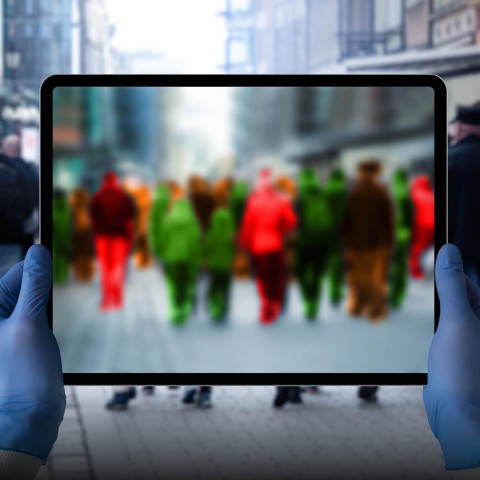Crowd Science Research Lab
A survey of pedestrian flows is taking place on the BUas campus. Using three cameras, pedestrian flows will be recorded for 1.5 years (1 February 2023 to 1 September 2024) for research and experimentation.
- About BUas
- Education
Visitors who are filmed are not recognisable in the footage and the images are not stored. The survey will be conducted under the banner of Logistics Community Brabant in cooperation with Breda University of Applied Sciences. The results of this survey will be analysed by the BUas Crowd Science Research Lab (CSR-lab). The survey complies with all legal frameworks the results are retrievable from BUas and/or LCB.
Background
The Netherlands is the world leader in (safely) organising logistics processes at events. However, in today's dynamic world, it is important to be flexible, innovative and progressive in order to maintain and, where possible, reinforce this privileged position. Research has shown that managing behaviour and organising processes safely and thoughtfully has a major impact on the safety of audience groups at venues where crowds gather. These include logistical hubs such as tourist sites, events, airports, railway stations and other public locations.
Predicting behaviour has so far proved to be 'wishful thinking'. The desire to realise this in the future is supported by various public and private parties. This has made BUas, with LCB as the ‘catalyst agent’, take the initiative to set up a Crowd Science Research Lab (CSR lab) on the BUas campus. Within it, various parties involved will carry out experimental research into the dynamics of visitor flows. In addition, behaviour is analysed and predicted where possible. Besides predicting, the CSR Lab also provides the opportunity to carry out experimental research into, for example, nudging, data collection, and the definition of key figures that support the Crowd Safety discipline. The aim of Crowd Safety is to be able to identify risky situations at an early stage and then intervene adequately. This contributes to safety where crowds come together for any reason.
Objective of the CSR Lab
The central aim of the Lab’s research is to understand the dynamics behind and within audience groups in order to use the insights thus gained to predict short-term behaviour for the purpose of creating opportunities to improve the safety of audience groups through interventions.
With the CSR Lab, BUas wants to study initiatives and experiments which are in the ‘discover’ phase. For the experiments in the Lab, several focus areas have been defined. These are:
- For educational purposes
- Minor in Crowd Safety
- For research purposes
- Daily pedestrian flows on campus
- Pedestrian flows during events (open days, parties, graduation ceremonies)
- Testing of interventions or experiments by means of nudging as well as various set-ups
- Educational projects (crossovers) with other academies and cooperation with partners
Privacy
The CSR Lab uses cameras from which data is extracted. This is then used to carry out analyses that may say something about people's behaviour and safety. This data is anonymised and only says something about the number of people per 1m2 (density), the speed within that 1m2 and the facial expression (mood) per 1m2 (positive, neutral, negative). This 'mood' is only represented and analysed using colour codes (i.e. not people). The basis on which the processing takes place is legitimate interest. Legitimate interest comes about after a balancing of interests. BUas’ interests in processing are weighed against the interests of data subjects not to be included.
As articulated above, there is a strong societal interest in visualising and mapping visitor flows during events and being able to contribute to increasing visitor safety during events. The invasion of privacy of people walking across campus and being recorded in this context is limited and kept to a minimum in the processing of this data. While recording the images, people are (potentially) recognisable in the image. These images arrive on a local server and are anonymised for analysis using face-blurring software. This ensures that people are no longer recognisable in the images. The blurred footage is then analysed by a small group of people as explained above. Only these researchers have access to this data. In other words, it is really about the flow of visitors and how groups of people move around the campus. With this, predictions can be made that are important for crowd management during events.
On the advice of the BUas Data Protection Officer, the following measures have been taken to safeguard or protect the privacy of data subjects when processing personal data:
- Anonymisation of images for analysis within the framework of the CSR Lab
- Local storage (not online in the cloud)
- Restricted and secured server access (at least two-factor authentication)
- Restricted and secured access to anonymised footage
- Short retention periods of camera footage, and a proper protocol for deletion is being carefully developed.
Rights
Students, lecturers and visitors have rights in terms of privacy. These can be read on the website of the Dutch Data Protection Authority (Autoriteit Persoonsgegevens).
